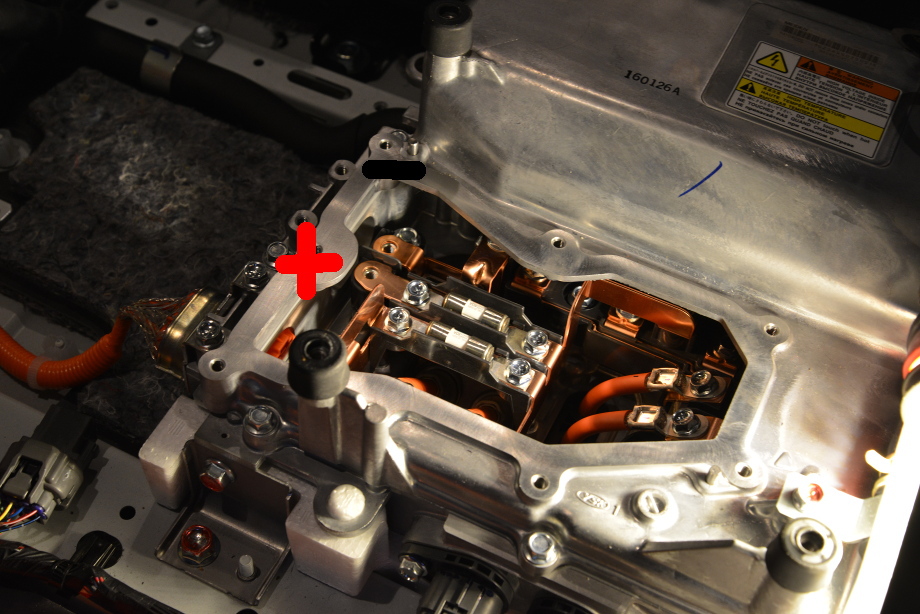PaulFromDe said:
A replacement battery would be an interesting product - in 8 years, when warranty ends.
:idea: Actually I'm very interested in an extension battery: :idea:
There is a huge amount of unused space under the trunk cover.
If you look under the car, you see the silencer at one side - and the other side is almost empty.
By moving the 12V-battery to another place there would be even more usable space.
The connector of the onboard charger or the heater at the rear motor could be used to connect a HV junction box.
There we could connect another 80-cell Li-Ion-battery.
Another 12 kWh, or even 19,5 kWh? That would give a range of about 136 km (85 miles).
I think, there must be a (strong) relay, and the extension battery must only be connected in the right state of the car (while driving).
Otherwise the on-board battery management unit would think of the additional current as a failure.
The second battery needs its own BMS for balancing and protection. Also, another charger is needed.
I think it is okay, if quick charging and recuperation would only work with the first battery.
@vtechtuning:
Please invent an extension battery for the Outlander!
I'm sure you could do that.
I'm using your PHEV-box, and it works fine!
Paul
I think you have a too optimistic view about 2nd battery
I think it can be added 1 or 2kwh battery nothing more then this
About BMS ... I think this pack definitely need to have e relay for be disengaged from main battery in case of "needs"
There is no need for special charger for it .. not really a BMS ... unless we consider BMS the control of the relay
Still there is one issue which is hard to control: temperature control of the added battery pack.
Main battery of the car has its own cooling system .. AC start in case of need in summer even when car is parked
So .. main issue is on hot summer day leaving the car in the sun, the car can go over 50/60 deg inside .. and over 60deg Lithium battery start to suffer.
Still an easy solution would be to make the pack removable and avoid to use it on summer.
About the BMS system for the 2nd pack ... I would design something very simple:
- Over voltage protection: Each cell need to have its own voltage check, and if 1st level of over voltage is detected then a little load local to the single cell should be used for discharge the cell. If a 2nd higher voltage level is reached ... then the additional battery pack need to be disconnected
- Under voltage protection .. (this should never happen actually) .. so it may be avoided ... but ... having a voltage detection point for each cell ... if voltage is too low for only on cell ... then 2nd battery pack should be disconnected .. and an "alarm" should be sent
- Charging ... 2nd battery can be charged while main battery is charged ... by just having this battery in parallel to the main one. Nothing special to be added here.
- BMS ... mainly the additional BMS is the controller of the switch/relay between the two batteries ... the relay should be open when: total voltage of the battery pack and additional battery has a difference above x Volts (x to be defined .. possible 1 or 2volt difference is acceptable .. above not) .. the load for discharge high voltage cell can be local to each cell (like a single cell protection for each cell) ... also will be nice to have bluetooth support for monitor the status of the relay and each single cell via a simple application
It may sounds a lot of words .. but it is something simple and cheap to achieve ... still it may add 50/100 USD to the cost of this 2nd battery pack
About the battery pack .. I see two option:
- Use decent quality Hobby RC battery pack .. like a 5.2mAh 4S 10C .. light pack from hobby king (this cost around 40USD, 20 will be needed .. for a total cost of 800USD)
- Use cheap Soshine 26650 5500mAh .. 4pcs cost 27USD .. so the pack will be costing around 540USD .. these should have in theory already protection for overcharge and overdischarge .. so in theory they cold be connected in parallel without much additional BMS .. still have a BMS for control the relay is not a bad idea
Both option will deliver 1.5kwh .. so ...the gain will be around 12% (from 50km to 56km range)
Added weight is ~8kg ... I think this can be hosted on the space under the main cover of the trunk, where is normally located the charger (which in my case is always at home and never in the car)
For me ... the first thing .. is find which is the ideal point to get access to the 300v battery pack ... so to gain also the automatic charging feature of it.
Yes ... if vtech can offer such a service for ~1000USD .. for adding ~1.5kwh ... in a well packed designed way .. it may have "market"
But ... it is a nice of a nice ... so I guess there is no business for vtech to follow it
I guess .. he may get ready for replace old battery pack, and get an upgraded one, when the 8y old pack is going out of warranty
I expect this to be a 6000USD service .. with almost no R&D ... just replace the old battery with some newer and more energy dense .. like the 19Kwh battery pack that he may be testing on his car
In absence of vtech .. it will be nice to share our know how .. mainly about how to get access in a safe and easy way to the main battery pack




























